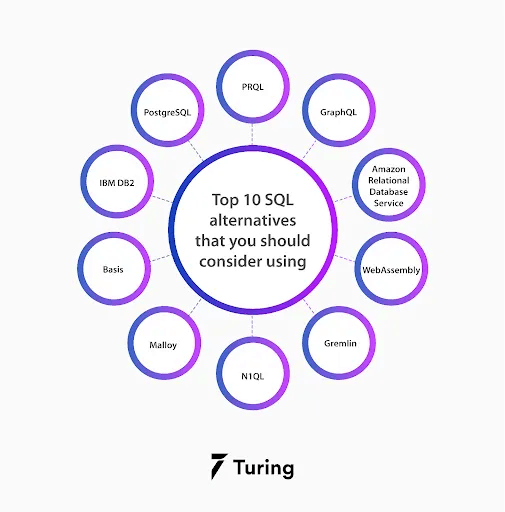Go Beyond SQL! 10 SQL Alternatives That You Should Use
•11 min read
- Software comparisons

Databases and Structured Query Language (SQL) were nearly synonymous over three decades. SQL was required for everyone who wished to obtain data from a database. There was no SQL alternative and anyone who wished to maintain a database or work as a database administrator had to learn the intricacies of the system.
SQL's syntax has been modified to make it a little neater and simpler to comprehend, making the transition between writing code for the browser and obtaining data a little less jarring. However, there are now many languages that can provide you with various features that SQL simply can’t. Curious to know which are they?
In this blog, I will walk you through the top SQL language alternatives you can use to help you crack the best SQL developer job interviews.

Top 10 SQL alternatives that you should consider using
PRQL
You will definitely appreciate PRQL, which stands for Pipelined Relational Query Language if you conceive of software as a pipeline or an assembly language (pronounced "Prequel"). This language's data querying system are made up of a series of tiny instructions. When all of the instructions are combined, you'll obtain a result that contains only the information you need.
Interested in SQL content? How about exploring SQL data analyst opportunities too?
Pros of PRQL
The mental model of a query follows a functional approach, similar to that of many current database query languages. Variables, for example, minimize duplication and streamline the flow. In a lengthy chain, the findings from one line are passed into the next. If you wish to delete a step from a pipeline, you can usually comment out that line, and the remainder of the pipeline will remain functional.
Cons of PRQL
PRQL is basically designed to replace SQL but it is at it’s pre-alpha stage hence it can not be used as a general-purpose programming language.
As a transpiler for turning PRQL to SQL, PRQL's code is built in Rust. Because the fundamental framework is customizable, you may add more abstractions to fit your needs. The language will change quickly as a result of the ease with which it can be experimented and hence, it’s a great SQL alternative.
GraphQL
The name GraphQL is a little misleading because it isn't truly a language built to make use of all the benefits of graph databases. GraphQL is more of an elegant shortcut for accessing data stored in layered JSON-like format. The query is just a description of how the results should appear.
Pros of GraphQL
The back end of GraphQL examines this set of fields, which may have value limitations, and attempts to match the results. GraphQL users merely supply a list of fields, whereas SQL defines how the database should execute a request which is why it is a good SQL alternative. It's referred to as "query by example" by some.
Although GraphQL is a natural fit for some JSON databases, it is also becoming increasingly popular for accessing relational databases with a tabular architecture. Smart backends can convert nested queries into a JOIN pattern that conforms to the schema.
Cons of GraphQL
Don't mistake GraphQL for a server-side database substitute. It is simply a query language. The server executes database access when a query is requested. When we need to access several fields in a single query, whether in a RESTful architecture or GraphQL, the various resources and fields must still be obtained from a data source. As a result, it exhibits the same issues when a client requests too many nested field data at once.
The initial language was developed as a Facebook internal project, but once it was released as an open-source project, others began building GraphQL backends. This SQL alternative has currently versions in all of the main languages, as well as a number of new experimental languages.
Amazon Relational Database Service
Amazon RDS enables you to quickly and cost-effectively install scalable MySQL servers with readily resizable hardware capacity.
Pros of Amazon RDS
This allows you to concentrate on application development while AWS handles many of the usual database management responsibilities including backups, patching, and monitoring.
You have a lot of control over these settings thanks to database parameter groups, which provide you extensive control and tweaking options for your database instances.
Cons of Amazon RDS
Amazon RDS for MySQL instances is pre-configured with parameters and settings that are specific to the instance type you've selected. With Amazon RDS, downtime is required for scaling operations.
Amazon RDS service manages thousands of databases for various clients, allowing them to develop best practices for optimising RDS instance use, security, and performance. Therefore, it is a good SQL alternative.
WebAssembly
Many programmers consider WebAssembly (abbreviated Wasm) a useful SQL alternative for developing speedy online apps. When Redpanda set out to create a data streaming tool to replace Kafka, they intended to include a method for not just providing data but also modifying it. They went with WebAssembly.
Pros of WebAssembly
WebAssembly programmers can tap into the stream at any moment in the past since events are added. Programmers can begin with newly formed events, while others may begin with historical aggregations in the past. In fact, WebAssembly is far more powerful and low-level than even the stored procedures found in certain databases. Not everyone wants to write byte-level, bit-banging code. However, the option allows for complex changes in the data stream that are not achievable with SQL languages.
Cons of WebAssembly
There is no garbage collection (GC) to allow for autonomous memory management (although there are plans to add GC). Instead of communicating with the Document Object Model (DOM) directly, it relies on JavaScript. Potential security flaws may make it easier for thieves to conceal malware, phishing attempts, and so on.
Despite this, WebAssembly has several advantages over other SQL Alternatives hence it can be considered for data querying.
Gremlin
Gremlin, one of the first languages for graph searching, requires a series of processes for searching across node connections. It's sometimes referred to as a "path-based" or "graph traversal" language. Each query is made up of stages which allows mapping the current node, filtering a list, or tabulating.
Pros of Gremlin
Gremlin is easier to embed with a Python interpreter inside it, allowing Python code to be included in queries. It is possible to integrate Gremlin into a conventional programming language such as Java.
Cons of Gremlin
There is no native scheduling feature. In Gremlin, there is no simple mechanism to launch attacks on many systems (without using certain drivers). Experiment creation requires a more hands-on, technical effort. Experiment portability is limited.
But, easy integration with other languages allowing programmers to use Gremlin from within that language which makes it up for a good SQL alternative.
N1QL
Couchbase has spent years figuring out the best approach to query generic documents wanting to create a SQL alternative. N1QL (pronounced "nickel") is a SQL extension that makes working with JSON objects in Couchbase easier for SQL natives. The query was originally constructed as a JavaScript function that was passed to the database to execute. It was a wonderful, generic solution that took a long time to get a result, but it forced programmers to think in new ways.
Pros of N1QL
In the same way, as SQL has numerous sections, a simple query contains several portions described by the terms SELECT, FROM, and WHERE. It will be able to index and query large amounts of data at scale. With Couchbase powering N1QL, querying and app development become that much more powerful. Couchbase's N1QL seeks to give developers more independence, flexibility, alignment, and productivity.
Cons of N1QL
Setting up and administering a big, high-performance cluster is difficult without the support of Couchbase. More lessons and documentation for enterprise scenarios are required. Poor speed and synchronization support for web-based programmes (PWAs, etc.).
When combining several capabilities (for example, transactions with Sync Gateway), you must exercise caution since one technology may not work properly in conjunction with another.
Malloy
Malloy is an experimental language for defining data relationships and transformations. It is a querying language that conducts queries against a relational database as well as a semantic modeling language. Malloy now supports BigQuery and Postgres, as well as DuckDB natively.
Pros of Malloy
According to Malloy's designers, the fault with SQL is in the syntactic subtleties. Because the language is verbose and full of hidden performance traps, even the simplest query takes long to express. So, instead of retrofitting a stock database, they designed a contemporary programming language with natural defaults and simplified syntax that can be converted to SQL. As a result, the syntax resembles a more advanced version of GraphQL.
In the background, Malloy takes care of some optimization. To prevent chasm and fan performance traps, for example, smarter JOINS can be constructed automatically. To save time, subqueries can be grouped together. As needed, indices are also added. As a result, query writing seems more like current code, with punctuation helping to keep the structure concise making it a worthy SQL alternative.
Cons of Malloy
They need to work on their documentation. Many developers require a page to compare between equivalent SQL and Malloy codes for complex queries.
Basis
The majority of query languages are related to a certain database. Basis is constructing a pipeline that can get data from a number of sources before filtering it using SQL and Python. Exporters at the conclusion of the pipeline transmit data to a number of standard alternatives, such as running code, AI algorithms, charts, and dashboards.
Pros of Basis
Many projects rely on similar architectures, and developers are already creating pipelines like this in their own programs. Basis has a prebuilt option that may be tweaked in a variety of ways. Standard database searches, API calls, and bespoke Python code are all examples of inputs. Because you can create Python code that does more than filter as the data travels down the pipeline, the transformers aren't confined to SQL's fundamental WHERE clauses.
#### Cons of Basis
Because the platform lacks cookie matching capabilities, match rates between desktop and mobile are low. Better performance solutions, retargeting, and conversion product development are required. If someone has never used a DSP before, they will require extensive hands-on training. As with any system, users who choose to utilize Basis must commit to training and using the system as much as feasible.
Basis is only one example of emerging data pipeline solutions that let users query data from several sources, filter it using multiple languages, and provide it in multiple formats. It's a vision of being able to transmit data from practically any source to almost any customer. You can make use of Basis as a SQL alternative if it meets your requirements.
IBM DB2
The fact that DB2 is an IBM product is a big plus. DB2 was developed many years ago in IBM's database laboratories and has since added feature after feature. DB2's Structured Query Language (SQL) dialect is more powerful than Microsoft's SQL dialect. Object tables, before triggers, Java method support, numerous user-defined methods, and array support are all available in DB2.
Pros of IBM DB2
After comprehensive testing, IBM releases software updates and fixes on a regular basis. The popularity of DB2 is due to IBM's high-quality software support, as well as the system reliability that emerges from such support. IBM's R&D funds continue to improve the product, making DB2 an excellent choice for an RDBMS. MS SQL does not support any of these capabilities. SQL provides immediate access to data using DB2's database administration interface. It may also be included in the code of applications developed in other languages like COBOL and Java.
Cons of IBM DB2
There is a lack of a current client tool for connecting to and querying databases.
The DB2 web console is not very stable. Long-term DB2 metrics data cannot be viewed.
New users may find it difficult to move XML data. For less experienced users, setup and implementation can be complex or unclear. Also, the documentation may be expanded to offer more information on the micro choices accessible in the UI's various menus.
DB2 is a robust relational database management system and a good SQL alternative because of its versatility and feature set.
PostgreSQL
PostgreSQL has earned a reputation as a strong, feature-rich relational database system. PostgreSQL is also a fantastic choice if you need flexibility in how you represent data and want to be able to utilize a number of tools and languages.
Pros of PostgreSQL
PostgreSQL is known for its superb implementation of key relational functionalities while remaining independent of typical RDBMS boundaries. In the ACID-compliant system, developers can define data types such as numeric, date/time, array, or geometric, create custom functions, and ensure data integrity using exclusion constraints, explicit locks, and primary or foreign keys.
Database managers can utilize SQL to conduct a range of data operations such as INSERT, UPDATE, DELETE, and others. While no database can meet every demand, PostgreSQL is a great solution that can handle a wide range of scenarios. It provides flexibility in data representation with a variety of tools.
Cons of PostgreSQL
Changes for performance improvement necessitate more work than in MySQL since PostgreSQL focuses on compatibility. Many open source applications support MySQL, but not PostgreSQL. It is slower than MySQL in terms of performance.
Also, PostgreSQL is not owned by a single company. As a result, although being fully featured and comparable to other DBMS systems, it has had difficulty getting its name out there.
PostgreSQL meets all of the criteria for many projects, valuing stability, functionality, and standards compliance making it a strong SQL alternative.
Conclusion
SQL has become the de facto standard language for database management systems (DBMS). However, it’s also known for its verbose syntax and lack of support for certain features. There are several alternatives to SQL that offer similar functionality. This article has given you a few of the best SQL alternative databases available today. WebAssembly, Malloy, PostgreSQL, IBM Db2- these are the best that you can use if you are looking to go beyond the Structured Query Language.

Author
Shivam
Shivam is a content writer who is passionate about writing about technology and software. He has been writing content on several niches for brands like Turing, Pepper Content, Xiaomitoday, and more. He is also a nature-aesthete. He goes by the philosophy of “being humanitarian first, then a professional.”